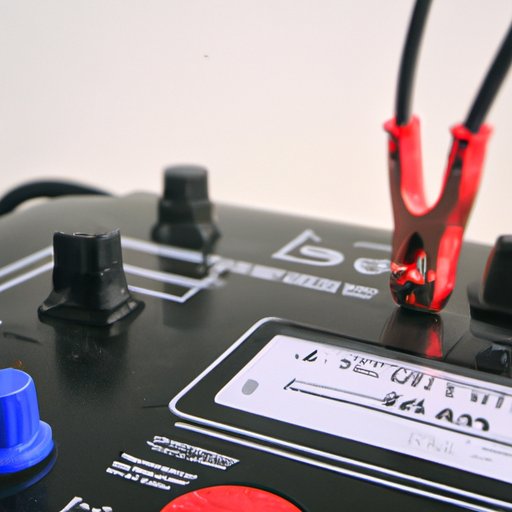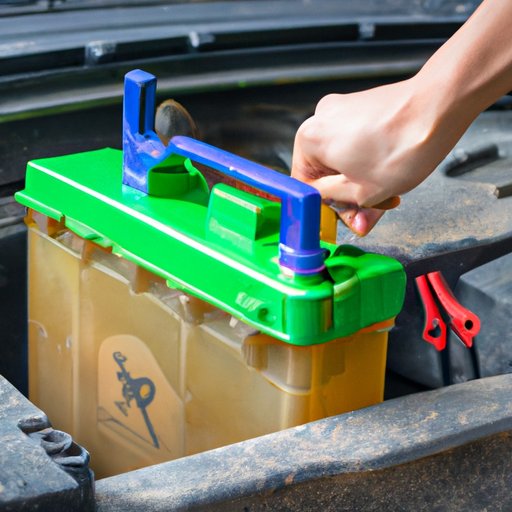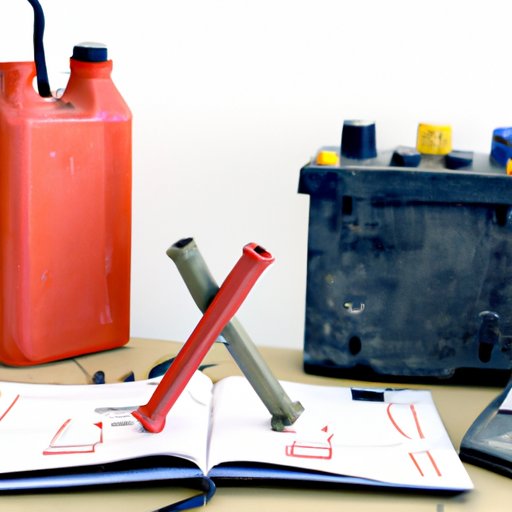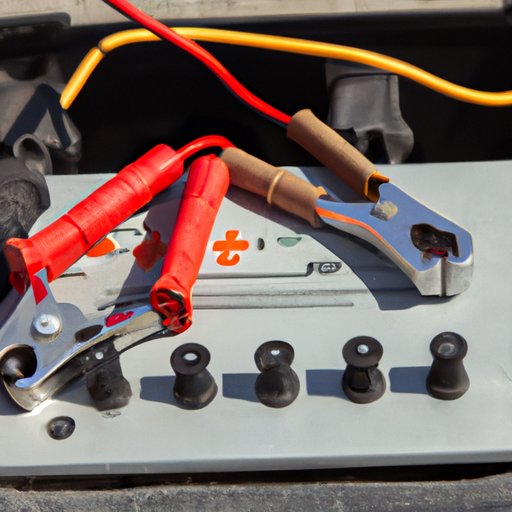Introduction
A car battery is a critical component in any vehicle, providing the power needed for everything from lighting to ignition systems. To ensure that your car battery is working properly, it’s important to test it periodically. While there are professional services available for testing car batteries, it can also be done at home with the right tools and knowledge. This article will provide a step-by-step guide on how to test your car battery at home, as well as some tips and considerations to keep in mind before doing so.
Step-by-Step Guide to Testing Your Car Battery at Home
Testing your car battery at home is a relatively simple process that doesn’t require a lot of specialized knowledge or expensive equipment. Here’s a step-by-step guide on how to do it:
Gather the Necessary Tools
The first step is to gather the necessary tools to test your car battery. You’ll need a digital multimeter, a pair of pliers, a wire brush, and a hydrometer. The digital multimeter is used to measure the voltage of the battery, while the pliers and wire brush are used to clean the battery terminals. The hydrometer is used to measure the specific gravity of the electrolyte inside the battery cells, which can indicate if the battery is fully charged or not.
Prepare the Vehicle
Once you have all the tools, the next step is to prepare the vehicle for testing. Make sure the engine is off and the headlights, radio, and other electrical components are turned off. Then, open the hood and locate the battery. Make sure to wear protective gear such as gloves and safety glasses while handling the battery to protect yourself from spills or splashes.
Check the Battery’s Voltage
Using the digital multimeter, check the battery’s voltage by attaching the red lead to the positive terminal and the black lead to the negative terminal. If the reading is between 12.4 and 12.7 volts, the battery is considered fully charged. Any reading lower than 12.4 volts indicates that the battery is low and needs to be recharged.
Clean the Battery Terminals
Next, use the pliers and wire brush to clean any buildup of corrosion from the terminals. Corrosion can prevent the battery from charging properly, so it’s important to make sure the terminals are free from buildup. Be careful not to touch the terminals with your bare hands, as this could cause an electric shock.
Check for Corrosion
After cleaning the terminals, check for any signs of corrosion on the battery casing. If any corrosion is present, use a mixture of baking soda and water to clean it off. Make sure to rinse off the area thoroughly afterwards.
Test the Battery with a Hydrometer
Finally, use the hydrometer to test the specific gravity of the electrolyte inside the battery cells. This will give you an indication of whether the battery is holding a charge or not. The specific gravity should be between 1.265 and 1.280 for a fully charged battery. Anything lower than 1.265 indicates that the battery needs to be recharged.

What You Need to Know About Testing Your Car Battery at Home
Before attempting to test your car battery at home, there are a few things you should know about car batteries and testing procedures. It’s important to understand the basics of car batteries, learn how to read hydrometer results, and be aware of safety precautions.
Understand the Basics of Car Batteries
To successfully test a car battery at home, it’s important to understand the basics of how they work. Car batteries are made up of cells, each of which contains a certain amount of sulfuric acid and lead plates. When the battery is charged, the sulfuric acid reacts with the lead plates to produce electrons, which provide the energy needed to power the vehicle.
Learn How to Read Hydrometer Results
When testing the specific gravity of the electrolyte with a hydrometer, it’s important to understand how to read the results. The hydrometer works by measuring the density of the electrolyte, which is indicated by a numerical value. A higher number indicates a higher density, which means the battery is fully charged. A lower number indicates a lower density, which means the battery needs to be recharged.
Be Aware of Safety Precautions
When testing a car battery at home, it’s important to take safety precautions to avoid injury. Wear protective gear such as gloves and safety glasses when handling the battery, and always disconnect the negative terminal first when removing the cables. Additionally, be careful not to overcharge the battery, as this can cause damage to the cells. Finally, be cautious when handling sulfuric acid, as it can cause skin irritation or burns.

How to Troubleshoot a Failing Car Battery at Home
If you’ve tested your car battery and determined that it’s not holding a charge, there are a few steps you can take to troubleshoot the problem. First, check the alternator to make sure it’s functioning properly. Next, check the battery cables for any signs of corrosion or fraying. Finally, check the battery charging system to make sure it’s working correctly.
Five Tips for Safely Testing Your Car Battery at Home
Testing your car battery at home can be a safe and effective way to diagnose any issues with your vehicle’s battery. Here are five tips to help you do it safely:
Wear Protective Gear
Always wear protective gear such as gloves and safety glasses when handling the battery. This will help protect you from any spills or splashes of sulfuric acid.
Disconnect the Negative Terminal First
When removing the battery cables, always start with the negative terminal first. This will help prevent sparks from forming and potential short circuits.
Use a Digital Multimeter
A digital multimeter is the best tool for testing the battery’s voltage. It’s more accurate than a standard voltmeter and easier to read.
Don’t Overcharge the Battery
Be careful not to overcharge the battery, as this can cause damage to the cells. Use a trickle charger to slowly recharge the battery instead.
Use Caution When Handling Sulfuric Acid
Sulfuric acid is corrosive and can cause skin irritation or burns. Always wear protective gear when handling it and be sure to rinse off any spills immediately.

The Pros and Cons of Testing Your Car Battery at Home
Testing your car battery at home can be a convenient and cost-effective way to diagnose any issues with your vehicle’s battery. However, it’s important to weigh the pros and cons before taking on this task.
Pros
One of the main benefits of testing your car battery at home is that it’s much cheaper than having it professionally tested. Additionally, it’s generally a quick and easy process that can be done in just a few minutes. Finally, it’s a great way to gain a better understanding of your vehicle’s electrical system and become more familiar with car maintenance in general.
Cons
While testing your car battery at home can be beneficial, there are also some drawbacks. For one, it requires some basic knowledge of car batteries and electrical systems. Additionally, it can be dangerous if not done properly, as sulfuric acid is corrosive and can cause skin irritation or burns. Finally, it’s important to remember that a home test is not as reliable as a professional one, so it’s best to consult a mechanic if you’re unsure of the results.
Conclusion
Testing your car battery at home is a relatively simple process that can save you time and money. With the right tools and knowledge, it can be done safely and effectively. However, it’s important to understand the basics of car batteries, learn how to read hydrometer results, and be aware of safety precautions before attempting to do so. Ultimately, testing your car battery at home can be a great way to diagnose any issues with your vehicle’s battery.
(Note: Is this article not meeting your expectations? Do you have knowledge or insights to share? Unlock new opportunities and expand your reach by joining our authors team. Click Registration to join us and share your expertise with our readers.)
